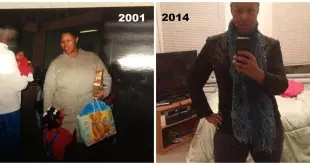You ever make a goal and it didn’t quite work? Were you left wondering why? I know I have been. But did you know there is actually a “recipe” for effective goals? There is! And I’m going to tell you about it.
Common Goal Pitfalls
I can’t speak for every single person, or even every single post-op, but when I talk to folks about why their goals aren’t working, the problem usually falls in one of these areas:
- They aren’t really sure what their goal is or how to know if they’ve gotten there
- They’ve made a goal that they think means something to them but it doesn’t really
- They’ve flat out made the wrong goal
- They have a goal but the actions they are taking aren’t really leading them toward it
Let’s examine these problems and what’s causing them.
#1 – Knowing Your Goal & Making Sure It’s Meaningful
I’ve heard it so many times before.
“What’s your goal?”
“To get healthier.”
“Well how do you know when that’s happened?”
“I’ll just know…”
No. You won’t just know. Because for many of us it’s been a while since we’ve been truly healthy and the fact that we were obese for any length of time lends to us not having the best grasp on what “healthy” means. I’m not going to try to define that here, mostly because it’s highly subjective to the person, but healthy can mean many things. In order to actually get to healthy you need to know what that means to YOU.
The best way I know how to define what our goals are – and tell how we’ve reached them – is through S.M.A.R.T. goals.
S.M.A.R.T. Goals are goals that are:
- Specific
- Measureable
- Achievable
- Relevant
- Time-sensitive
Here’s the breakdown of how to make a S.M.A.R.T. Goals
Specific: Which, of course, is the opposite of vague. So:
- No = “I will eat better.”
- Yes = “I will eat a protein forward diet with plenty of fresh fruits, vegetables and complex carbohydrates.”
Measure-able: Because unless you draw a finish line for your goal, how do you know if you’ve crossed it?
- No = “I pledge to eat less carbs and more protein.”
- Yes= “I pledge to eat less than Xgrams of carbs per day and more than Xgrams of protein”
Achievable: This is where most New Years Resolutions go wrong. Too lofty.
- No = I want to weigh 75 lbs.
- Yes = I want to reach a healthy weight according to the Body Mass Index.
Relevant: Is this goal really important to you? That may seem like a dumb question, but sometimes we do things in the name of a goal that we don’t like (figuring the ends justify the means). But if we think of goal-setting as a life-long process, we see that’s just not sustainable! Make sure your goal means something to you and has relevance in your life!
- No = I want to run a marathon this summer (when running really isn’t your thing)
- Yes = I want to learn to swim. (because you’ve always loved the water)
Timely: Open-ended goals are goals that stand a very high chance of never getting achieved. Make yourself accountable to the goal by either setting a due or benchmark dates.
- No = I’m going to lose these last five pounds someday.
- Yes = I want to lose this last five pounds within the next four months.
These are just examples, of course, but making S.M.A.R.T. goals can help you know what your goal is, know when you’ve reached it, and make sure you are making the right goal for what you actually want to happen.
#2 – Goals vs. Mini-Goals
This concept can be confusing in writing, but let’s give it a go!
Everyone has a BIG GOAL. I personally think it’s best if that is a S.M.A.R.T. Goal but I also understand that making a BIG GOAL into a S.M.A.R.T. Goal can be tricky.
No matter what your BIG GOAL is, in order to achieve it, you usually need to:
- adopt some new behaviors
- achieve a series of smaller tasks or milestones
The behaviors or changes you must adopt to get to your BIG GOAL, you might call mini-goals. The smaller or milestones involved in changing that behavior could be called yoru actions.
What’s tricky about mini-goals is that unless you consider them against your BIG GOAL, you might think they are leading you to your BIG GOAL when they actually aren’t.
I’ll give you an example.
Say Mary wants to lose 100 lbs. She decides one thing that needs to change to be able to do this is that she needs to eliminate all carbs from her life. She finds that she does ok with that for short periods of time, but that every once in a while she just goes off the rails and eats every carb she can get her hands on! This always causes her to regain at least 3-5 lbs. of what she’s lost and she has to start over again.
For Mary, losing the weight is the BIG GOAL.
Eliminating carbs is the ACTION.
But is Mary’s action really leading her toward her BIG GOAL? Obviously not if she can’t stick to it. Not only is there a problem in the S.M.A.R.T. realm, but also this goal, in practice really isn’t taking her where she wants to go.
So Mary decides, instead, that one of the actions she needs to lose the 100 lbs. is to be more aware of what she eats and to control the amount and types of carbs she eats. Her activities there are planning her meals so they contain complex carbs and journaling her food to hold herself accountable. If you’re like me, you probably didn’t think there was much wrong with her first mini-goal but now can you see how it wasn’t leading her to her BIG GOAL? I hope so!
#3 – Planning is Key
Like I said above, making goals that succeed requires planning. It need not be hours or days or weeks, but you do need to mindfully think about:
- What you ultimately want to achieve (your BIG GOAL)
- What you need to change or do to get there (your mini-goals)
- What actions those changes require
When you take all these things together, you design goals meant to succeed. But a WARNING. They may not succeed on the first try. You may still have made a misstep along the way and sometimes life just happens. But the beauty of making goals this way is that when something goes wrong it’s much easier to identify and fix the problem! Think of it like taking a road trip. If you know where your destination is you know where you are supposed to be going. If you plan out your goals, mini-goals and actions, you have a roadmap. But sometimes when you are on a road trip you can still get lost! But when you have a roadmap you can retrace your steps back to a place where you know what mistake you made and how to fix it.
I hope this is helpful to you in making goals that truly succeed. If you need a place to work out those goals, I’ve got a treat for you!
My “How to Make Goals That Succeed” Work Plan takes you through this whole process, step-by-step, so that you can see how your BIG GOAL, mini-goals and actions all fit together. Enjoy!
 Bariatric Foodie Play with your food
Bariatric Foodie Play with your food




Nie zgadzam się z Tobą, ale ok
so, my SMART goal, today…right now… *to lose 5 lbs/jumpstart my stall/ in 1-1.25lb wkly increments, by consuming enough cal's daily,being mindful of my water intake, and exercising more commitedly, setting my phone alarm reminders, and having a buddy review my action plan with me daily, within the next 3 weeks.(Feb 11-13)* Specific, Measurable,Action-plan,Realistic, Timely. (??)
My big day is on Monday. My goal for right now is to stick to the plan of 4 shakes/day without unapproved additions and no snacks.
kd416 – I love the part of a buddy review. Great way to be held accountable!
I will ride my bike for 30 minutes Thursday and Friday this week before dinner. Trish Kavanagh
Where can I find the How to Make Goals That Succeed” Work Plan? Would like to fill out a work sheet and take it with me to my Psycholocial assessment appointment that I have today. Thanks Ricky Joe
Hi Ricky Joe,
If you fill out the form below with your name and email address it gets delivered straight to your inbox!
I would like one too
Hey there. If you are talking about the goals that succeed worksheet, be sure to fill out the form on the page and I’ll send it straight to your email!